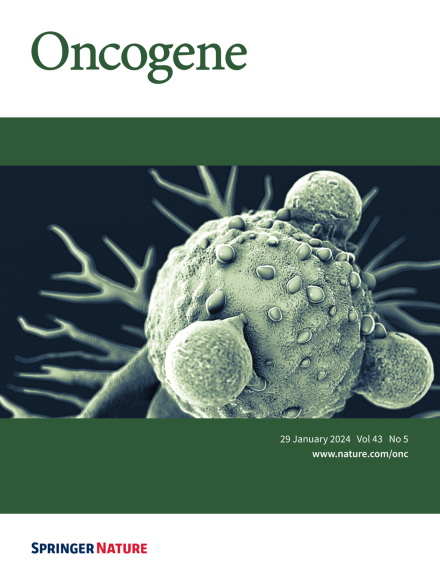BCL-6 POZ结构域和其他POZ结构域与共抑制因子N-CoR和SMRT相互作用
IF 6.9
1区 医学
Q1 BIOCHEMISTRY & MOLECULAR BIOLOGY
引用次数: 310
摘要
几乎所有弥漫性大细胞淋巴瘤和相当一部分滤泡性淋巴瘤都含有假定致癌基因BCL-6的5′非编码区的易位和/或点突变,据推测这将导致其表达失调。BCL-6编码一个Cys2-His2锌指转录抑制因子,其氨基末端有一个POZ结构域。POZ(或 BTB)结构域是一个 120 氨基酸的基团,可介导同构体之间的相互作用,在某些蛋白质中还可介导 POZ-POZ 异构体之间的相互作用。此外,包括 BCL-6 在内的几种蛋白质的转录抑制都需要 POZ 结构域。通过酵母双杂交筛选,我们发现 N-CoR 和 SMRT 是与 BCL-6 相互作用的蛋白。N-CoR和SMRT最初被鉴定为无连接核甲状腺激素和视黄酸受体的共抑制因子,它们都是含有组蛋白去乙酰化酶的大型复合物的组成成分。我们的研究表明,BCL-6 与这些共抑制因子之间的相互作用也能在更贴近生理的哺乳动物双杂交试验中被检测到。POZ结构域是与这些共抑制因子相互作用的必要和充分条件。BCL-6 和 N-CoR 共同定位在细胞核的点状区域。此外,当 BCL-6 在体内与其共识识别序列结合时,它能与 N-CoR 和 SMRT 相互作用。我们在体外发现,来自其他多种含 POZ 结构域的蛋白质(包括转录抑制因子 PLZF 以及 ZID、GAGA 和一种疫苗病毒蛋白 SalF17R)的 POZ 结构域也能以不同的亲和力与 N-CoR 和 SMRT 相互作用。我们发现,破坏与 N-CoR 和 SMRT 相互作用的 BCL-6 POZ 结构域突变不再抑制转录。此外,这些突变不再有自身关联,这表明自身相互作用是与共抑制因子相互作用和抑制所必需的。最近,N-CoR 也与 Mad/Mxi 蛋白的转录抑制有关。我们的研究表明,N-CoR 和 SMRT 与含 POZ 结构域的蛋白相互作用,这表明这些共抑制因子可能参与了多类抑制因子的抑制作用,并在一定程度上解释了含 POZ 结构域的抑制因子是如何介导转录抑制作用的。本文章由计算机程序翻译,如有差异,请以英文原文为准。
The BCL-6 POZ domain and other POZ domains interact with the co-repressors N-CoR and SMRT
Virtually all diffuse large cell lymphomas and a significant fraction of follicular lymphomas contain translocations and/or point mutations in the 5′ non-coding region of the putative oncogene BCL-6, that are presumed to deregulate its expression. BCL-6 encodes a Cys2-His2 zinc finger transcriptional repressor with a POZ domain at its amino-terminus. The POZ (or BTB) domain, a 120-amino-acid motif, mediates homomeric and, in some proteins, heteromeric POZ-POZ interactions. In addition, the POZ domain is required for transcriptional repression of several proteins, including BCL-6. Using a yeast two-hybrid screen, we identified N-CoR and SMRT as BCL-6 interacting proteins. Both N-CoR and SMRT, which were originally identified as co-repressors for the unliganded nuclear thyroid hormone and retinoic acid receptors, are components of large complexes containing histone deacetylases. We show that the interaction between BCL-6 and these co-repressors is also detected in the more physiologically relevant mammalian two-hybrid assay. The POZ domain is necessary and sufficient for interaction with these co-repressors. BCL-6 and N-CoR co-localize to punctate regions of the nucleus. Furthermore, when BCL-6 is bound to its consensus recognition sequence in vivo, it can interact with N-CoR and SMRT. We find, in vitro, that POZ domains from a variety of other POZ domain-containing proteins, including the transcriptional repressor PLZF, as well as ZID, GAGA and a vaccinia virus protein, SalF17R, also interact with varying affinities with N-CoR and SMRT. We find that BCL-6 POZ domain mutations that disrupt the interaction with N-CoR and SMRT no longer repress transcription. In addition, these mutations no longer self associate suggesting that self interaction is required for interaction with the co-repressors and for repression. More recently N-CoR has also been implicated in transcriptional repression by the Mad/Mxi proteins. Our demonstration that N-CoR and SMRT interact with the POZ domain containing proteins indicates that these co-repressors are likely involved in the mediation of repression by multiple classes of repressors and may explain, in part, how POZ domain containing repressors mediate transcriptional repression.
求助全文
通过发布文献求助,成功后即可免费获取论文全文。
去求助
来源期刊

Oncogene
医学-生化与分子生物学
CiteScore
15.30
自引率
1.20%
发文量
404
审稿时长
1 months
期刊介绍:
Oncogene is dedicated to advancing our understanding of cancer processes through the publication of exceptional research. The journal seeks to disseminate work that challenges conventional theories and contributes to establishing new paradigms in the etio-pathogenesis, diagnosis, treatment, or prevention of cancers. Emphasis is placed on research shedding light on processes driving metastatic spread and providing crucial insights into cancer biology beyond existing knowledge.
Areas covered include the cellular and molecular biology of cancer, resistance to cancer therapies, and the development of improved approaches to enhance survival. Oncogene spans the spectrum of cancer biology, from fundamental and theoretical work to translational, applied, and clinical research, including early and late Phase clinical trials, particularly those with biologic and translational endpoints.
 求助内容:
求助内容: 应助结果提醒方式:
应助结果提醒方式:


